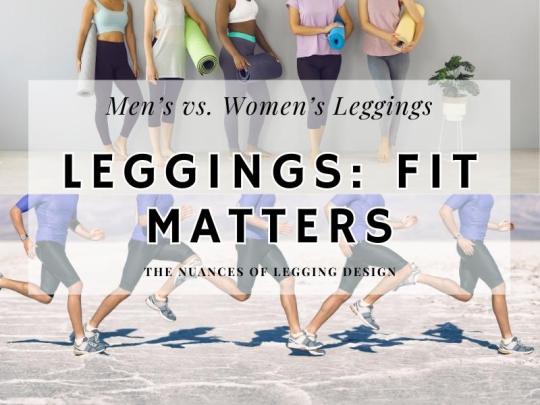Text
What Women Really Need to Know About Leggings: A Complete Guide

Hey Tumblr fam! Let's talk leggings. They're not just a style staple; they're a must-have in your fitness wardrobe. But let's be real, not everyone knows the deets that can make or break your leggings experience. So, let's get into the nitty-gritty of what you should keep an eye out for.
1. It's All About the Fabric
Your leggings' material is key to how comfy and effective they are. Go for fabrics that wick away sweat and let your skin breathe, like a mix of polyester and spandex. Trust me, you'll thank yourself during those sweaty HIIT sessions.
2. Fit is Everything
Don't sleep on the importance of fit. Too tight or too loose just won't do. You want something that gives you a bit of compression but doesn't limit your moves. Experiment with different sizes and cuts to find your perfect match.
3. Waistband Wonders
Don't underestimate the power of a good waistband. High-waisted leggings give you that extra support and can even give the illusion of a slimmer figure. But if that's not your jam, low-waisted ones might be more up your alley.
4. The Squat Test
Before you hit that 'buy' button, do a quick squat test to make sure they're not see-through. Save yourself the embarrassment, seriously.
5. Pockets, Please!
Some leggings come with pockets, and it's a game-changer. Perfect for stashing your phone, keys, or whatever small stuff you carry. Especially handy if you're jamming to your workout playlist.
6. Seasonal Vibes
Depending on the season, you might need different leggings. Mesh panels are a summer fave, while insulated leggings are winter workout heroes.
7. Go Beyond Black
Black is a go-to, but why not spice it up with some colors or patterns? It can add a dash of fun to your workout and might even boost your mood.
8. TLC for Your Leggings
Want your leggings to last? Follow the care instructions. Air-drying is often the way to go to keep that stretch intact.
9. You Get What You Pay For
It's tempting to go budget, but sometimes splurging a bit on quality leggings is a wise move. Better comfort, longer life, and enhanced performance? Yes, please.
10. One Legging to Rule Them All
Look for leggings that can do it all—yoga, running, or even just lounging. The more versatile, the better value you get.
Leggings are more than just a piece of clothing; they're a lifestyle, especially if you're into fitness. Knowing the ins and outs can make a world of difference in your comfort and performance. So keep these tips in mind next time you're on the hunt for a new pair.
Quick Disclaimer: Just a heads-up, the tips here are general advice. Everyone's different, so you might want to consult a pro for personalized recommendations.
Hope this guide helps you find your dream pair of leggings. Happy shopping, y'all! ✌️
#fitness#healthy lifestyle#workout#fitnesstips#healthy life#healthy food#nutrition#leggings#tight leggins#legginslove
2 notes
·
View notes
Text
Optimizing Your Gym Time: A Guide to Unlock the Perfect Gym Session

Hey, Tumblr fam! 🏋️♂️ Ever pondered how long to pump those irons or torch those calories at the gym? Let's clear the fog:
Your Goals Matter: Building muscle? You might need longer sets. Going for weight loss? Short, intense workouts could be your jam.
Intensity Over Hours: Sometimes, a fierce 45-minute workout can outdo a lazy hour. Quality over quantity, always.
Frequency: Got time? Multiple short trips might serve you better than a single prolonged one.
Moves That Matter: Get more bang for your buck with multi-joint exercises.
Supersets & Circuits: Boost that heart rate! Great for strength and getting that cardio in.
Rest Is Key: Short rests for stamina, longer for power.
Fuel Up: Pre and post-workout munchies? Vital.
Mindful Movements: Ensure you’re feeling every rep.
Quick Cardio: Throw in speedy cardio bursts. Burn those cals!
Clock Management: Plan. No more idling between sets.
In this fitness journey, it's not just about the clock. Tailor your routines, vibe with your goals, and ensure every moment counts. It’s not just about the minutes in the gym, but making each minute count. Dive into these strategies, find your rhythm, and let those gains shine through!
Disclaimer: Always vibe with a healthcare pro before diving into new fitness adventures. This is general advice, not a medical prescription! Stay safe, stay fierce! 💪🌟🎧
0 notes
Text
How do People Estimate the Calorie Count of Food?

Navigating the ever-evolving realm of health and wellness demands a nuanced comprehension of the intricate art of gauging calorie content in foods. In an era of diverse dietary preferences and consumption patterns, individuals are increasingly seeking reliable avenues to assess the energy quotient of their sustenance. The fusion of expertise in calorie estimation has risen to prominence, seamlessly intertwining with the domains of both nutrition and fitness. Within this illuminating dialogue, we shall plunge into the multifaceted approach individuals employ to approximate food calorie counts, shedding light on invaluable strategies that seamlessly meld with the most recent currents in the fitness sphere.
The process of approximating food calorie counts emerges as a dynamic endeavor, necessitating a fusion of empirical wisdom, scientific insights, and ingenious tools. As enthusiasts embark upon their fitness voyages, discerning the energy content of assorted edibles becomes paramount to fine-tuning dietary decisions. Presented herein are ten actionable measures that offer a remedy to the conundrum of accurately estimating calorie counts:
Meticulous Nutritional Label Scrutiny: Commence your journey with a fastidious perusal of nutritional labels, centering your focus on serving sizes and calories per serving. This foundational step imparts an instantaneous glimpse into the energy content of packaged victuals.
Reliable Digital Culinary Scales: Devote resources to a dependable digital culinary scale. Weighing ingredients pre-cooking or consumption allows for pinpoint calculations of calories, proving instrumental in portion regulation and precision-based estimation.
Power of Recipe Analysis Tools: Harness the potential of web-based recipe analysis tools, facilitating the input of ingredients and serving dimensions. These tools perform computations for overall calorie counts, streamlining the procedure for homemade culinary creations.
Utility of Calorie Estimation Applications: Employ mobile applications exclusively tailored for tracking and approximating calorie counts. These apps often boast extensive databases brimming with victuals and their corresponding energy values.
Visual Analogies for Comparison: Cultivate a discerning eye for portion magnitudes via visual juxtapositions with familiar objects. For instance, a standard deck of cards could equate to an appropriate meat portion.
Insights into Caloric Ratios: Acquaint yourself with the caloric ratios of macronutrients. Protein and carbohydrates harbor roughly 4 calories per gram, while fats yield approximately 9 calories per gram. This knowledge expedites the process of estimating calorie counts grounded in nutrient composition.
Deconstructing Ingredients: Disassemble complex culinary concoctions into their individual constituents. Summing the caloric content of each element furnishes a near approximation of the entire dish's energy value.
Preliminary Survey of Restaurant Menus: When dining out, invest time in investigating restaurant menus in advance. A multitude of dining establishments furnishes nutritional data online, thus facilitating well-informed choices.
Cognizance of Metabolic Rate: Factor in your unique basal metabolic rate (BMR) and activity level. This personalized approach engenders a more precise estimation of your caloric requisites.
Professional Consultation: Embark on a quest for guidance from certified dietitians or nutritionists, esteemed for their ability to dispense individualized insights and meticulous approximations in line with your objectives and dietary inclinations.
As the panorama of health and fitness continues its metamorphosis, mastery over the art of estimating calorie counts empowers individuals to make judicious dietary selections. By embracing these methodologies, one can nimbly navigate the intricate tapestry of nutrition with conviction, harmonizing dietary practices with aspirational fitness goals.
Disclaimer: The content presented above is intended for general informational purposes only. The insights provided herein serve an educational purpose and should not supplant professional medical or nutritional counsel. Always solicit the advice of a qualified healthcare provider prior to executing significant modifications to your dietary or exercise regimen.
0 notes
Text
How do I build muscle without any equipment?

Diving into the realm of fitness, the path to forging robust muscles often conjures images of elaborate gym setups and cutting-edge equipment. Yet, rejoice in the revelation that the absence of gear should never impede your odyssey toward realizing muscle-building triumphs. The human physique is an extraordinary marvel, and armed with astute methodologies, you can exploit its latent potential to carve and amplify your musculature sans the customary tools of the trade. Be it the throes of a time crunch, the allure of a home-based regimen, or an affinity for untrodden avenues, there exist potent avenues to foster muscular growth in the absence of apparatus. Within this comprehensive discourse, we shall plunge into an array of pragmatic strides and resolutions, designed to shepherd you through this hardware-free expedition toward muscle amplification.
Bodyweight Marvels: Embrace the potency of your corporeal weight by assimilating maneuvers like push-ups, squats, lunges, and planks. These multifaceted gestures rally diverse muscle clusters while championing universal robustness and equilibrium.
Calisthenics Symphony: The domain of calisthenics, a variant of bodyweight schooling, proffers an eclectic tapestry of exercises – from pull-ups and dips to a spectrum of handstand iterations. Such motions subject your musculature to a gamut of angles, nurturing muscle augmentation and utilitarian potency.
Advancing Onslaught: Devoid of established weights, center your attention on escalating your onus progressively, be it through heightened repetitions, heightened intensity, or the augmentation of exercise intricacies. By gingerly urging your muscles, you kindle incessant growth and adaptation.
Isometric Tableaus: Isometric holds, the ilk of wall stances and plank derivations, herald protracted tension within muscles. This fosters resilience and contributes to muscular maturation.
Plyometric Choreography: Effervescent kinetics such as squat propulsion and burpees galvanize your heart rate while amplifying muscular dynamism. Plyometrics jolt the fast-twitch muscle fibers, instrumental in muscular hypertrophy.
Resilience Ribbons: Although technically contrivances, resilience bands boast versatility and mobility. They confer variable opposition, elevating exercises such as bicep undulations, rows, and leg elevations.
Tempo Tapestry: Orchestrating the rhythm of your movements, akin to retarding the descent juncture of a push-up, augments the temporal span of tension. This ignites muscle expansion.
HIIT Choreography: High-Intensity Interval Training (HIIT) oscillates betwixt intense outbursts of exertion and succinct convalescent junctures. This methodology galvanizes muscular growth while effacing calories.
Yoga and Pilates Fusion: These practices interlace bodyweight calisthenics with suppleness and equilibrium training, magnifying muscle tonality and operability.
Nutritional Oasis and Reprieve: Bear in mind, sustenance and recuperation are pivotal. Ponder protein assimilation, retain hydration, and allot adequate rest for muscular restoration and augmentation.
Erecting musculature bereft of paraphernalia stands not merely as a viable prospect, but one teeming with exhilaration. By deftly harnessing bodyweight maneuvers, calisthenics, progressive loading, and other visionary stratagems, you possess the ability to sculpt a sinewy and unyielding physique. Keep in mind the tenets of consistency, commitment, and an equilibrium-based nutritional regimen. With zest, venture into this fitness expedition devoid of hardware, unearthing the awe-inspiring potential harbored within your own frame.
Disclaimer: Prior to initiating any novel exercise protocol, it is judicious to solicit guidance from a medical practitioner, especially if any latent health apprehensions or medical conditions prevail. The insights furnished in this response are designed for generalized counsel and didactic motives solely. The outcomes for each individual may diverge grounded on sundry constituents, and the architect of this discourse shall not be deemed accountable for any injuries or adverse consequences stemming from the adoption of the proffered insights. Safety and personal compatibility should invariably be paramount while partaking in physical pursuits.
0 notes
Text
Do men who wear leggings notice a difference between men’s and women’s leggings?
Meggings vs. Leggings: What's the Real Deal?

Leggings: Not just a closet staple for women anymore. With guys getting into the legging game (aka "meggings"), many are asking: How do they stack up against the ones made for ladies? Dive in with me to explore the differences.
Breakin’ Down the Legging Game
Fit & Flow: Ladies' leggings? Made to fit their unique curves, with a snug waist and roomy hip vibe. Guys? They get a more chill fit, especially around the hips.
Crotch Comfort: Guys' leggings are usually packing a gusseted crotch - it’s all about that space and ease. Women's versions? Maybe not so roomy.
Rise & Shine: Ladies have all sorts: from those high-waisted faves to the chill low-rise. Guys? Usually rocking that mid-rise look.
Patterns, Length & More: Women might get shorter leggings sometimes, but they sure get to play with cooler designs. Guy leggings? A bit more on the down-low, but watch this space for some fun patterns.
Thickness & All That Jazz: Some dudes reckon women’s leggings feel a tad thin. But remember, it’s all about what it’s made for and who makes it. Oh, and a shoutout to those men's leggings with pockets. Real MVPs.
Thinking of rocking women’s leggings, gents? Best to play around with brands. Find your fit, find your style.
In a Nutshell:
Leggings? Universal. But their designs vibe with the unique shapes of guys and gals. As meggings become the talk of the town, knowing these deets can help pick your perfect pair, whether for style, sport, or just lounging.
Slide into my follows for the latest on fitness fashion & all things legging lore.
FYI: This is all casual talk, not pro-advice. Rock what you feel good in, and remember: Your style, your rules. Always vibe with what feels 100% you.
2 notes
·
View notes
Text
How often should you work out to gain muscles?

I'm thrilled to share valuable insights on how to optimize your workout frequency to maximize muscle gain. Building muscles requires a well-crafted exercise routine that strikes the perfect balance between training intensity, recovery, and consistency. In this post, I'll dive into the recommended workout frequency, supported by scientific research and industry best practices. Whether you're new to fitness or a seasoned enthusiast, understanding the ideal workout frequency is essential for achieving your muscle-building goals.
Here's what you need to know:
Define your goals: Before determining your workout frequency, it's crucial to establish your muscle-building objectives. Are you aiming for overall muscle gain or focusing on specific muscle groups? Clearly defining your goals will help tailor your training program accordingly.
Embrace progressive resistance training: To effectively stimulate muscle growth, it's essential to gradually challenge your muscles. Consider incorporating compound exercises like squats, deadlifts, and bench presses, along with isolation exercises targeting specific muscles.
Train muscle groups 2-3 times a week: Research suggests that working each muscle group 2-3 times a week is optimal for muscle growth. This frequency allows for sufficient recovery while providing enough stimulus to promote muscle hypertrophy.
Implement split routines: Dividing your workouts into separate days for different muscle groups can promote proper recovery and prevent overtraining. For example, you can focus on upper-body exercises one day and lower-body exercises the next.
Prioritize rest days: Rest and recovery are as crucial as training itself. Ample rest enables your muscles to repair and grow stronger. Aim for at least 1-2 rest days per week to avoid overexertion.
Pay attention to workout intensity: The intensity of your workouts significantly impacts muscle growth. Ensure that your exercises are challenging enough to stimulate muscle fibers but not so intense that they lead to injury. Gradually increase weights or resistance as you progress.
Consider your fitness level and schedule: Your current fitness level and lifestyle factors, such as work commitments and recovery ability, should influence your workout frequency. If you're a beginner, starting with 2-3 sessions per week and gradually increasing frequency can be a sensible approach.
Incorporate active recovery days: Active recovery days involve low-impact activities like stretching, yoga, or light cardio. These aid in blood circulation, reduce muscle soreness, and promote overall recovery.
Listen to your body: Everyone's body is unique, so it's crucial to pay attention to how you feel. Excessive fatigue, prolonged muscle soreness, or a lack of progress may indicate the need to adjust your workout frequency or intensity.
Seek professional guidance: If you're uncertain about designing a workout program tailored to your specific needs, consulting a certified fitness professional can provide personalized advice and ensure you're on the right track.
In conclusion, the ideal workout frequency for muscle gain varies based on factors such as goals, fitness level, and recovery ability. However, a general guideline is to work for each muscle group 2-3 times per week, incorporating proper rest and recovery days. Remember to progressively challenge your muscles, prioritize rest, and listen to your body's signals. By following these recommendations, you can optimize your workout routine to safely and effectively achieve your muscle-building goals.
Disclaimer: Please note that the information provided in this post is for educational purposes only. It is not intended to substitute professional medical advice, diagnosis, or treatment. Always consult with a qualified healthcare provider before starting any fitness or exercise program. Additionally, engaging in physical activities carries inherent risks, and it's important to proceed with caution considering your individual health condition and physical limitations.
2 notes
·
View notes
Text
How Can You Lose Fat and Build Muscle at the Same Time?

Embarking on a fitness journey often poses a perplexing question: "Is it possible to shed fat and gain muscle simultaneously?" While these goals may seem contradictory, a well-planned diet, targeted exercise, and diligent monitoring can make this dual aim a reality. Let's explore how to carve a lean physique with defined muscles without succumbing to counterproductive habits.
Nutrient Equilibrium: Your diet should be rich in protein for muscle development, complex carbohydrates for workout energy, and healthy fats for hormone regulation.
Resistance Training: Engaging in weightlifting and resistance workouts boosts muscle size, which subsequently improves metabolism and promotes fat reduction.
High-Intensity Interval Training (HIIT): Rapid, vigorous exercise bouts followed by brief rest intervals can burn more fat while preserving muscle mass compared to constant-rate cardio.
Gradual Intensity Increase: Consistently enhancing the intensity, volume, or frequency of your workouts guarantees ongoing muscle development and avoids stagnation.
Sufficient Rest: Muscles develop during rest, not during the workout. Make sure you're getting enough sleep and taking rest days between intense training sessions.
Steady Caloric Shortfall: A minor caloric deficit is essential for fat loss. However, the deficit shouldn't be too severe to avoid muscle loss.
Protein Timing: Eating protein-rich meals after workouts can boost muscle recovery and development.
Hydration: Keeping well-hydrated can support all bodily functions, including fat metabolism and muscle performance.
Stress Control: Elevated stress levels can obstruct your body's ability to shed fat and build muscle. Incorporate stress management techniques like meditation, yoga, or simply taking a walk outdoors.
Regular Monitoring: Keep track of your progress consistently. Assess body composition instead of solely depending on the scale as muscle is denser and weighs more than fat.
Conclusion: Simultaneously achieving fat loss and muscle gain is a challenging task, but it's undoubtedly achievable with strategic planning and disciplined implementation. Proper nutrition, the right exercise types, and adequate recovery can guide you toward a leaner, more muscular body. The journey may be tough, but the results are unquestionably gratifying.
Disclaimer: This guidance is intended to be general and may not apply to your specific situation. Always consult with a certified fitness professional or your healthcare provider before initiating any new exercise program or making significant dietary changes. It's crucial to listen to your body and address any discomfort promptly. Your health and safety should always be your top priority.
3 notes
·
View notes
Text







6 Key Strategies to Trim Belly Fat and Achieve a Toned Tummy
Embrace Full-Body Workouts
Boost your calorie burn and overall fat loss by engaging in exercises that work for multiple muscle groups simultaneously, contributing to a slimmer waistline.
Personalize Your Cardio Regimen
Design a cardio routine that matches your fitness level. Beginners can opt for low-impact activities, while more experienced individuals can try high-intensity workouts to maximize fat loss.
Develop a Strong Core
Strengthen your entire core with targeted exercises such as plank variations and leg raises. Adjust the difficulty to match your fitness level for a solid foundation and enhanced stability.
Fine-tune Your Nutrition
Incorporate nutrient-dense, whole foods into a balanced diet and watch your portion sizes to support weight loss and belly fat reduction efforts.
Prioritize Restful Sleep
Aim for 7-9 hours of quality sleep each night to aid recovery, regulate appetite, and maintain overall well-being for all fitness levels.
Keep Stress at Bay
Practice stress management techniques such as mindfulness meditation, regular exercise, and nurturing social connections to help control cortisol levels and minimize stress-related weight gain.
Disclaimer
The information provided in this guide is for educational and informational purposes only. It is not intended as a substitute for professional medical advice, diagnosis, or treatment. Always consult with a healthcare professional before starting any new exercise, or nutrition program, or making changes to your existing routine, particularly if you have existing health concerns or are new to fitness. Our goal is to offer insights and tips to help you make informed decisions, but your individual needs and circumstances may vary, and it is essential to prioritize your health and well-being.
#bellyfat#weightloss#fitness#health#nutrition#exercise#cardio#fullbodyworkout#corestrength#healthydiet#sleep#stressmanagement#fatloss#tonedtummy#flatstomach#fitnessgoals#fitnesstips#healthylifestyle#workoutmotivation#bodytransformation#weightlossjourney#healthyeating#fitlife#wellness#getfit#fitfam#personaltraining#gymmotivation#fitnessinspiration#fitspo
7 notes
·
View notes